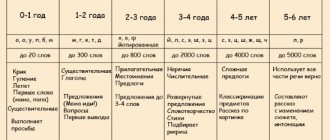Techniques for correcting deficiencies in the voicing of consonants; article on speech therapy on the topic
Techniques for correcting deficiencies in the voicing of consonants.
Often, a defect in the sonority of consonant sounds is caused by decreased hearing; in other cases, the cause is undeveloped phonemic hearing or poor coordination of the combined work of the vocal and articulatory apparatus. The task of correcting this defect is to achieve simultaneous operation of articulatory movements and vocal cords, which in most cases is not always achieved easily and requires a skillful approach.
1. Development of phonemic hearing (the usual method is used)
2. Education of the combined work of the articulation-phonation apparatus.
With a mild degree of violation, the elimination of such a defect, the consonants are arranged as follows: V, Z, Zh, B, D, G. In this group of disorders, the first exercises should be carried out mainly on the visual and musculocutaneous analyzers, and most importantly, in the beginning, in no case should you give a “say B” attitude. You need to approach sound voicing gradually, through systematic exercises.
The general techniques for all cases are the following:
1. The speech therapist pronounces this sound, and the child touches his larynx with his hand and feels the trembling of the vocal cords (to perceive the vibration of the vocal cords, the back of the hand should be applied to the larynx, since tactile-vibration sensitivity is best transmitted through the bones, and in this part there are many bones and they are located close to the skin). Next, the child himself pronounces this sound, simultaneously holding one hand on his larynx and the other on the speech therapist’s larynx. As a result of this technique, a ringing sound is often obtained. In addition to vibration, the movement of the entire larynx as a whole is also used.
2. One of the effective techniques is the use of a “pigeon voice” (dove cooing). It is produced by the larynx with the mouth closed (but not into the nose). When the child has mastered it, we suggest “walking” in front of the voiced consonant sound and “running up”, without a pause, pronouncing it. It is especially good to use this technique when voicing plosive consonant sounds (B, D).
3. Vowel sounds are pronounced successively and protractedly, each first in a whisper and then loudly. After this, we proceed directly to a similar pronunciation of the desired consonant sound.
An example of voicing the sound “Z”:
Whisper - A Whisper - And
Loud -A Loud -I
Whisper - E Whisper - S
Loud - E Loud - Z
The child, imperceptibly for himself, by analogy with vowels, due to the formed stereotype, also pronounces consonants, i.e. “Z” is pronounced loudly. It is important that adjacent articulations of the vowel and consonant are similar (I-S, O-Sh, U-V, A-K).
To voice plosive consonants, sounds are pronounced abruptly on one exhalation:
Whisper - A, A, A, A. In a whisper - E, E, E, E.
Loud - A, A, A, A. Loudly – E, E, E, E.
Whisper - O, O, O, O. Whisper - T, T, T, T.
Loud - O, O, O, O. Loud - D, D, D, D.
First we voice fricative sounds, and then plosives.
4. Fricative sounds are sometimes easy to voice in this way: we pronounce the consonant in a whisper, and then, without interruption, the voice is given under the direction of the speech therapist: F, P, T, S, Sh, K.
C, B, D, H, G, G.
5. Sometimes voicing is achieved by using a sign on which unvoiced sounds are compared with the corresponding voiced ones. A child, knowing or having relearned the sonority of the easiest consonant for him in one vertical pair, looking at the table, often pronounces the rest of the series of sounds by analogy.
You should pay attention to the voicing of consonant sounds in cases of “underdeveloped” voicing. To do this, deaf and voiced are compared and thus a fundamental difference is established between them. To enhance the vocal component, the child is asked to cover his ears with his hands or plug the ear canals with his fingers and pronounce V or Z, ZH. Then, using hand control of the vibration of the larynx, the semantic meaning and the difference between voiced and voiceless sounds are explained using paronyms. These techniques, of course, are also useful in the case of a complete absence of sonority.
In all exercises for voicing consonants, the “voice background” should be performed with a soft voice beginning. In difficult cases, during pronunciation it is useful to lightly “shake” the larynx with your fingers. Since voiced consonants have a lower tone than voiceless ones, when voicing you need to practice in a low tone. A high tone contributes to stunning. The resulting voiced sound is pronounced with vowels (before and between vowels), between vowels and voiced consonants (primarily M, N, P), taking into account the effect of regressive assimilation. For example: (for D) yes, to....,ada, ado.....,adma....,adna..,adra,adza,adja,....,house,one,admiral,jungle,abyss....
Voicing of sound V.
1.B – labial sound, here the vocal cords and lips are already working simultaneously.
2. The lips close so loosely that a continuous vocal-exhalatory current of significant strength can pass through them. A special buzzing sound is formed, and the lips vibrate with a vibrator tremor (slight tickling sensation), to control which the child touches his fingertips either to the speech therapist’s lips or to his own.
3. When performing the exercise, the mouth periodically opens wide and produces syllable-like sounds: wa-va-va. To cause vibration of the vocal cords and control it, both in this and in subsequent cases, it is useful to put the child’s hand to the larynx of the speech therapist while pronouncing sounds – the child feels her trembling and does the same on himself.
4. By ear, imitating a speech therapist, different combinations with vowels are pronounced: wa-vo-vu; ava-avo-avu.
5. In front of the mirror, the sound B is set, then the following technique is first performed: while exhaling, we pronounce alternately the labial-labial and labiodental B: in in in in in in.
6.Then we include the new sound in speech according to the general scheme, while at first we should focus on the differentiation of sounds B – A: wa-fa, carriage-bassoon, moisture-flags, etc.
Vocalization of the sound Z.
1. Having set the organs of articulation to the sound C, the child pronounces against the background of continuous vocal sound (s) on one long exhalation, repeatedly moving the tongue forward, lightly touching the edges of the upper and lower incisors, but so that air can pass through the interdental space. Here it is necessary Be very careful to ensure that the sound of the indefinite vowel type ы is not interrupted in any way.
2. Then it is proposed to do the same, but with maximum exhalation force, so that the tip of the tongue vibrates with a small tremor. As a result of this technique one hears: EZEZEZEZ. In this case, Y is pronounced drawn out, and Z is pronounced briefly, so that the voice does not interrupt. The sound is checked by touching the larynx with your hand.
3. When you get a completely sonorous Z, then by ear a series of combinations with vowels is done so that the Z is between the vowels, repeatedly and on one exhalation: AZY-AZY-AZY-AZA-AZU, etc.
4. We pronounce the combinations: FOR, ZO, ZU....; the same thing repeatedly and on one exhalation: FOR-ZA-ZA-ZA. It is useful here to use a combination of stressed syllables with unstressed syllables, that is, to emphasize either the first or the second syllable. This promotes clarity and ease of pronunciation.
5. The combination of Z with vowels and adjacent voiced consonants: ZMA..., ZVA..., ZNA..., IZBA, UZDA, EDZDA...
6. Differentiation between Z and S is made: ZA-SA, SA-ZA, TOOTH-SOUP...; then we include it in speech in the usual way.
Voicing the sound J.
In the presence of a voiced Z, while pronouncing this sound, the tip of the tongue gradually and carefully, but without losing its trembling, rises up, approaches the setting of the Z sound and is fixed in this position with subsequent exercises. This technique first creates conditions for a diffuse sound that differs little from the sound Z, and then, using hearing, differentiation of the sound Z from Z is achieved.
Vocalization of sound B
Exercises for sound B can have three physiological aspects, each of which turns out to be more beneficial to the child’s individuality.
The first system of exercises comes from articulatory movements typical of B.
The second is from labiolabial V.
The third is from the labiolabial nasal M.
If the first approach fails, we use the second and third. Often these approaches are combined.
1. The starting point is the articulation of sound B.
- it is proposed to tighten the “pigeon voice” when articulating the sound B and pronounce it carefully, without explosion (a fuzzy sound close to B is obtained), and then gradually move on to the explosive B, pronouncing it with the vowel sounds A, O, U, E.
- emit a “pigeon voice”, and then vigorously tear the tightly closed lips with compressed air, pronouncing A - you get BA.
- in the same way we pronounce BA, BO, BU, BY, BE.
- to reinforce these sound combinations, they are pronounced with a “wood splitter” motion.
- then we pronounce various combinations: BA-BO-BU, ABA, IZBA, BABA without the preliminary “pigeon voice”.
- the following techniques are also successfully used: a child with an open mouth presses tightly to the back of the hand, and then, strongly puffing out his cheeks and emitting an indefinite vowel sound, quickly lifts his hand from his mouth while simultaneously shouting out the sound A and the combination BA is obtained - similar to a shot. When the sonority of the sound is sufficiently revealed, we gradually reduce the tension of the cheeks and exhalation until they reach normal B, after which we include it in speech in the usual way, having previously firmly differentiated it from P in the already known ways: PA-BA, BO-PO, PAPA- BABA, STICK-BEAM......
2. The starting point is the articulation of the labiolabial sound B.
- on a full exhalation, the labial-labial B is pronounced with a gradual transition at the end of the exhalation to the sound B. With B the lips are brought together, and with B they are tightly closed: ВВВВ-BA... If this technique does not give a quick result, then at the moment of the explosion the lips are compressed with the fingers and the child is asked to reproduce the sound B and at the moment of the explosion the result is not B, diffuse B. You can use one more technique - while pronouncing the labiolabial B, we quickly move the index finger up and down between the lips, then opening, then closing the lips. If at the moment of closing pronounce the vowel sound A, you get the syllable BA. Gradually slowing down the movement of the finger, we move on to clearly pronouncing the syllables: BA-BE-BU, etc.. Then the sound is consolidated by repetition.
-alternation of combinations with labial-labial B and B: WA-BA.VO-BO...,WABA,BAVA,VUBU,BOVU, etc.
-alternation of words with labial-labial V and B: Vanya in the bathhouse, Vanya – bathhouse, thief-borer, barka-cooking……
- combination of B with different vowels.
-combination B with vowels and consonants in the words: hut, jug...
-inclusion of B into speech.
3. The starting point is the sound M.
-against the background of a drawn-out pronunciation of the sound M (moo), a quick B is pronounced, with preliminary puffing of the cheeks, with a breakthrough of tightly compressed lips: MMMBA (at the same time, at the moment of the lip explosion, the nose is pinched with the fingers)
-the combination BA is separated from MMM by a short pause: MMMM-BA.
- we pronounce by imitation BA, BA, BA.
-further work is carried out in the usual way.
In this technique, we proceed from the general articulatory moments of the biomechanics of the sounds M and B. By puffing out our cheeks and tightly closing our lips, we achieve a sharp opening of the mouth and lips, a strong stimulation of the palate - it rises up and closes the passage to the nose, as a result of which air breaks through the oral cavity and closed lips outward. This produces the sound B.
Voicing of sound D.
After voicing the previous series of consonants, voicing subsequent consonants is achieved relatively easily. The child has already developed a conditioned reflex for the functioning of the vocal cords, i.e. a certain stimulus (the attitude to pronounce loudly) immediately causes the vocal cords to work in combination with this articulatory attitude. But if the first attempts to pronounce a voiced imitative D are unsuccessful, then you have to resort to special exercises.
1. The child imitatively pronounces: BABABADADADA; further BADA-BADA-YES-YES-YES. If, as a result of irradiation of the vocal cords, the sound D is not pronounced loudly, then we move on to other techniques.
2. Sound B, which must be learned firmly and must be pronounced with a sharp, pronounced explosion. Then we ask the child to stick his tongue between his lips and in this position pronounce: BA-BA-BA... The auditory impression is reinforced by the visual (the lesson takes place in front of a mirror) and tactile (we feel the vibration of the larynx). The result is a sound B, which already has some shade towards D. The next stage The exercise is that the upper and lower lips are moved away from the tongue with your fingers so that articulation is made only with the tongue inserted between the teeth - from the interlabial, interdental D is obtained. Here you need to ensure that when you remove the lips, you do not get a repeated sound - instead of an explosive one - a frequent phenomenon, to eliminate which it is necessary to return to the pronunciation of B and interlabial D, with a special exaggerated minting of the explosion. When interdental D is achieved with sufficient clarity, then we move the tongue, first simply back behind the teeth, and then up, to the alveoli, and then we do all the exercises to consolidate the sound.
Voicing of the sound G.
The most difficult sound in terms of voicing is the sound G. Based on the southern Russian fricative G (let's denote it G*). This sound is usually immediately acquired by children. Again, against the background of the vowel overtone E (Y), the fricative G* is re-pronounced. Further in this exercise, the back of the tongue rises higher and higher to the sky, so in the end it turns out: EG*KG*E ,EG*GG*E... By accelerating the pace of the exercise, it is easy to achieve that the instantaneous K with the sounds G*G* begins to sound like G. It turns out: E G*G G*E,E G* G G* E. Then we transfer the emphasis on the last syllable. After this, the exercise takes the form: EGE, EGE. Next, the sound E is gradually replaced by another vowel: EGI, EGA, IGY... Then, using the usual method, we differentiate G from K and include the sound G in speech.
Article:
The sounds [b], [b' - b] normally appear in a child between the ages of 0 and 1 year.
If a child at 1 year old does not have the sounds [b], [b'], visit a consultation with a speech therapist who works with young children.
How to pronounce the sound [b].
- Vocal cords are closed and trembling;
- The teeth are open;
- The lips are closed at first, then they open under the pressure of the air stream;
- The tongue is passive, spread wide, the tip is moved away from the front lower incisors, moved back;
- The soft palate is pressed against the back wall of the pharynx.
- Articulatory features of sound [ b ] .
[b] – consonant sound. The air escaping from the oral cavity meets a barrier, closed lips;
[b] – mouth sound. The soft palate is raised, the small tongue is pressed against the back wall of the pharynx, air enters only into the oral cavity;
[b] – ringing sound. When pronouncing the sound [b], the vocal cords are closed, vibrate, and a voice is formed;
[b] – stop-plosive sound according to the method of formation. The bow is formed by the lips;
[b] – labial-labial sound at the place of formation. A barrier to the air stream is formed by the lower and upper lips.
- Acoustic signs of sound [ b ] .
[b] – the sound is ringing, noisy, instantaneous;
[b] - hard sound - the middle part of the back of the tongue does not take an active part.
- Sound disturbances [ b ] .
The pronunciation of the sound [b] is extremely rarely violated:
- absence of sound [b] - with pronounced defects of the lips.
- replacement of the sound [b] with the labiodental sound [v], with the sound [m] with open rhinolalia.
- mixing the sound [b] with the sound [p] - interchanges often towards deafening.
How to pronounce the sound [b'].
- Vocal cords are closed and trembling;
- The teeth are open;
- The lips are pressed more closely to the teeth, the corners are slightly moved apart;
- the tongue moves forward, the front and middle parts of the back rise to the hard palate.
1). Articulatory features of the sound [b'].
[b'] – oral sound. The soft palate is raised, the small tongue is pressed against the back wall of the pharynx, air enters only into the oral cavity;
[b'] – consonant sound. The air escaping from the oral cavity meets a barrier, closed lips;
[b'] – voiced sound. When pronouncing the sound [b'], the vocal cords are closed, vibrate, and a voice is formed;
[b'] – stop-plosive sound according to the method of formation. The bow is formed by the lips;
[b'] – labial-labial sound at the place of formation. A barrier to the air stream is formed by the lower and upper lips.
2). Acoustic signs of sound [b'].
[b'] – sonorous, noisy, instantaneous sound;
[b'] – soft sound. The middle part of the back of the tongue rises towards the hard palate.
3). Sound disturbances [b'].
The pronunciation of the sound [b'] is violated extremely rarely:
- absence of sound [b'] - with pronounced defects of the lips.
- replacement of the sound [b'] with the labial-dental sound [v'], with the sound [m'] with open rhinolalia.
- mixing the sound [b'] with the sound [p'] - interchanges often towards deafening.





